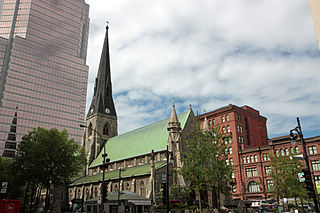
Christ Church Cathedral is an Anglican Gothic Revival cathedral in Montreal, Quebec, Canada, the seat of the Anglican Diocese of Montreal. It is located at 635 Saint Catherine Street West, between Avenue Union and Boulevard Robert-Bourassa. It is situated on top of the Promenades Cathédrale underground shopping mall, and south of Tour KPMG. It was classified as historical monument by the government of Quebec on May 12, 1988. In 1999, it was designated a National Historic Site of Canada.

Manchester Cathedral, formally the Cathedral and Collegiate Church of St Mary, St Denys and St George, in Manchester, England, is the mother church of the Anglican Diocese of Manchester, seat of the Bishop of Manchester and the city's parish church. It is on Victoria Street in Manchester city centre and is a grade I listed building.

The Cathedral-Basilica of Saint Louis, King of France, also called St. Louis Cathedral, is the seat of the Roman Catholic Archdiocese of New Orleans and is the oldest cathedral in continuous use in the United States. It is dedicated to Saint Louis, also known as King Louis IX of France. The first church on the site was built in 1718; the third, under the Spanish rule, built in 1789, was raised to cathedral rank in 1793. The second St. Louis Cathedral was burned during the great fire of 1788 and was expanded and largely rebuilt and completed in the 1850s, with little of the 1789 structure remaining.
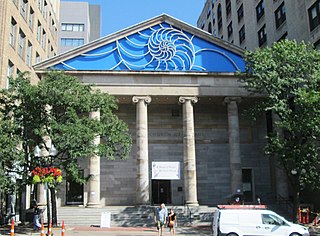
The Cathedral Church of St. Paul, Boston is the historic cathedral church of the Episcopal Diocese of Massachusetts. Located at 138 Tremont Street near Downtown Crossing, directly across from Boston Common and Park Street Station, the cathedral is adjacent to the diocesan offices. On April 22, 2018, Amy E McCreath was named the ninth dean and first female dean of the Cathedral Church of St. Paul, and was installed as dean on September 29, 2018. The church, designed by Alexander Parris and Solomon Willard and built in 1819, was the first Greek Revival church in New England, and was designated a National Historic Landmark in 1970 for its architectural significance.

The Cathedral of St. John the Baptist is the mother church of the Roman Catholic Diocese of Charleston, located in Charleston, South Carolina. Designed by Brooklyn architect Patrick Keely in the Gothic Revival style, it opened in 1907. The Most Reverend Jacques E. Fabre, the fourteenth Bishop of Charleston, was ordained and installed on May 13, 2022

The Episcopal Burying Ground and Chapel is located at 251 East Third Street, in Lexington, Kentucky. The land was purchased in 1832 by Christ Church as a burial ground for its parishioners. The cemetery became extremely important during the 1833 cholera epidemic, during which one-third of the congregation died.

The Episcopal Diocese of Kentucky is a diocese of the Episcopal Church in the United States of America, encompassing the western half of the state of Kentucky.

St. Mark's Episcopal Church, also known as St. Mark's, Capitol Hill, is a historic Episcopal church located at 3rd and A Streets, Southeast in the Capitol Hill neighborhood of Washington, D.C. Built 1888–1894, the church is an example of Gothic Revival and Romanesque Revival architectures.

The Episcopal Diocese of Lexington is the diocese of The Episcopal Church with jurisdiction over eastern Kentucky. It was created in 1895 from the Diocese of Kentucky which continues to have jurisdiction of the western portion of the state. The cathedral for the Diocese of Kentucky is located in Louisville. The Diocese of Lexington is in Province 4 and its cathedral, Christ Church Cathedral, is in Lexington, as are the diocesan offices. The diocesan office is called Mission House.

Christ Church Cathedral is the cathedral for the Episcopal Diocese of Indianapolis. Christ Church parish was formally organized in 1837. The present-day church building was erected in 1857 on Monument Circle at the center of downtown Indianapolis to replace the parish's first church built on the same site. Designed by architect William Tinsley, the English Gothic Revival-style structure is the oldest church building in Indianapolis and Marion County, Indiana, that has remained in continuous use. It is also the oldest building on Monument Circle. Christ Church is known for its music, especially its pipe organs, one of which was donated by Ruth Lilly, and its professional Choir of Men and Boys and Girls' Choir. The parish is also known for its community service, including an annual strawberry festival fundraiser and other charitable work. Christ Church Cathedral was added to the National Register of Historic Places on July 10, 1973. It is located in the Washington Street-Monument Circle Historic District.
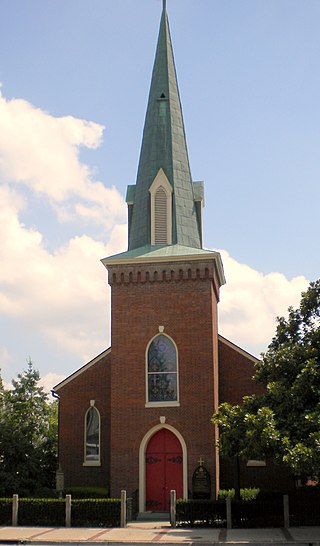
Trinity Episcopal Church in Danville, Kentucky was one of the first churches organized in the Episcopal Diocese of Kentucky. Trinity Church is the oldest in-use church structure in Danville and the oldest continuously used Episcopal church building in the Episcopal Diocese of Lexington as well as the second oldest in Kentucky. It is listed in the National Register of Historic Places.

St. Paul's Protestant Episcopal Church, more commonly called Old St. Paul's Church today, is a historic Episcopal church located at 233 North Charles Street at the southeast corner with East Saratoga Street, in Baltimore, Maryland, near "Cathedral Hill" on the northern edge of the downtown central business district to the south and the Mount Vernon-Belevedere cultural/historic neighborhood to the north. It was founded in 1692 as the parish church for the "Patapsco Parish", one of the "original 30 parishes" of the old Church of England in colonial Maryland.

St. Paul's Episcopal Church is a parish of the Episcopal Church in Cleveland Heights, Ohio. The current rector is the Rev. Jeanne Leinbach, installed on October 23, 2015. She is the first female rector of St. Paul's. Her predecessor was the Rev. Alan M. Gates, who served from 2004–2014, before his election as Bishop of Massachusetts. St. Paul's is a leading church and has the largest congregation in the Episcopal Diocese of Ohio.

Alfred Harding was the second Episcopal Bishop of Washington. He was elected in 1909 to succeed the Henry Yates Satterlee, the founding bishop of the Diocese of Washington (1896–1908). Harding was de facto dean of the Cathedral from 1909 until 1916.
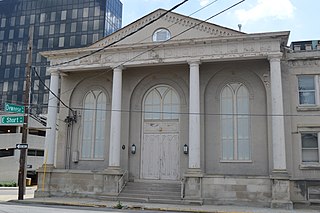
First African Baptist Church is a historic church at 264-272 E. Short Street in Lexington, Kentucky. The congregation was founded c. 1790 by Peter Durrett and his wife, slaves who came to Kentucky with their master, Rev. Joseph Craig, in 1781 with "The Travelling Church" of Baptists from Spotsylvania, Virginia.
London Ferrill, also spelled Ferrell, was a former enslaved man and carpenter from Virginia who became the second preacher of the First African Baptist Church in Lexington, Kentucky, serving from 1823 to 1854. During his 31 years of service, Ferrill attracted and baptized many new members in the growing region; by 1850 the church had 1,820 members and was the largest of any congregation in the state, black or white.
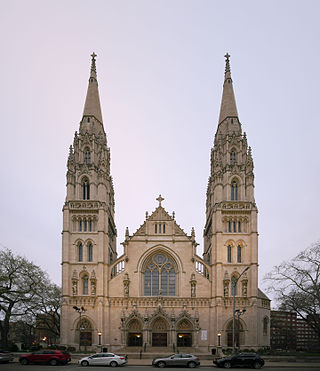
Saint Paul Cathedral is the mother church of the Diocese of Pittsburgh in Pittsburgh, Pennsylvania. St. Paul's parish was established in 1833.

Christ Cathedral is the cathedral church for the Episcopal Diocese of Western Kansas. It is located in Salina, Kansas, United States, and has been listed on the National Register of Historic Places since 2010.
The following is a timeline of the history of Lexington, Kentucky, United States.
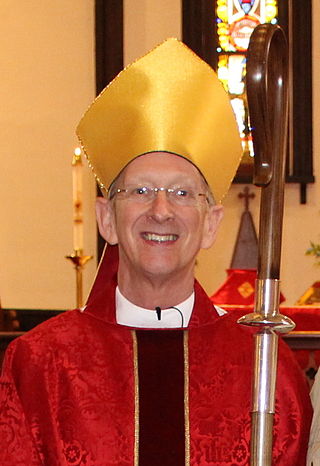
Douglas Hahn is an American prelate who served as the seventh Episcopal Bishop of Lexington. He was elected on August 18, 2012, and consecrated on December 15, 2012, in Lexington, Kentucky. He served until March 9, 2016, when he was suspended for one year for lying during the bishop interview process about past adultery with a parishioner. In October of that year, the Standing Committee of the diocese asked that Hahn resign as head of the diocese. In December, Hahn agreed to resign as of the end of his suspension, on March 10, 2017.




















